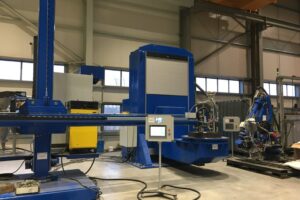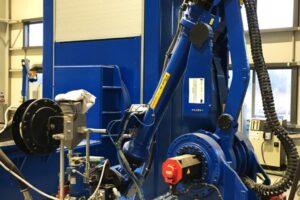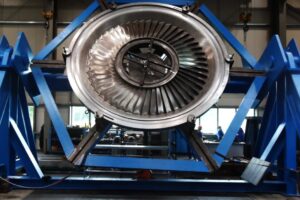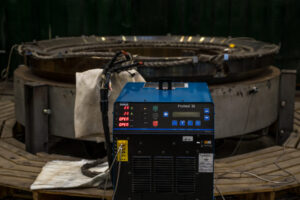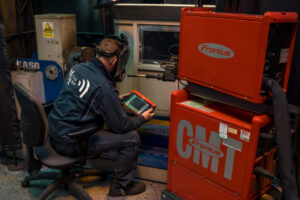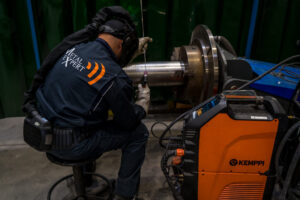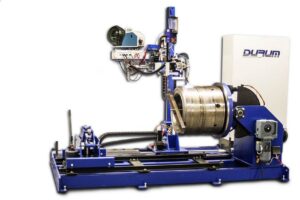Welding
Among the many metal joining companies, Meta Expert stands out for its great flexibility and a wide range of welding processes. We have manual methods, partially automated processes, fully automated, and robotic welding techniques.
-
The welding processes are carried out and controlled according to the implemented standard PN-EN ISO 3834-2 “Quality requirements for fusion welding of metallic materials – Comprehensive quality requirements.”
We have experience in welding practically all material groups of steel, including the challenging-to-weld energy-grade martensitic steels. Successfully, we implement welding processes for materials that a decade ago were considered unweldable.
We have numerous qualified welding technologies – over 200 approved Welding Procedure Qualification Records (WPQRs) according to industry standards and customers specifications:
- EN ISO 15614-1
- EN ISO 15614-7
- EN ISO 15613
- ASME SECTION IX
- APMM000014
- SCV M 59003D
- P8A-AL-0908
- P8A-AL-0907
Our experienced team of welders is certified in all auxiliary material groups for welding steel and nickel alloys. Welders and qualified operators adhere to European, American, and industry-specific standards.
The entire welding process is overseen by an experienced and International Institute of Welding (IIW) certified welding supervision team.
-
Welding with a non-consumable electrode in a neutral gas shield. This method allows achieving a very high quality of welds.
-
Welding with a consumable electrode in a neutral gas shield. This method allows achieving high quality with high efficiency.
-
Welding with a consumable electrode in an active gas shield. This method allows achieving high quality with high efficiency and cost limitation.
-
Shielded metal arc welding (SMAW), also known as stick welding, is a method that allows for the welding process to be carried out across a wide range of filler materials, including alloy steels, cast iron, and nickel alloys.
-
- Submerged arc welding with a flux-cored wire on a column-and-boom manipulator. This highly efficient automated welding method allows achieving high quality and repeatability over long sections of longitudinal and circumferential welds. The method is primarily used for welding deep and narrow weld joints of the “narrow gap” type.
- Submerged arc welding with a flux-cored wire on a robotic workstation. This high-efficiency method is performed with great precision and repeatability. It is also primarily used for welding deep and narrow weld joints of the “narrow gap” type. Welding in a groove allows for welding variable shapes, such as oval welds.
-
Plasma arc welding with powder. This method is characterized by a very flat and wide bead face, along with shallow penetration into the base material. We apply this technology for surfacing wear-resistant “hardfacing” layers using cobalt-based powders (6, 6LC, 21, 25) and nickel-based powders (Alloy 617).
- Certificates and approvals
- Equipment
- TIG welding (141)
- MIG welding (131)
- MAG welding (135)
- MMA welding (111)
- SAW welding (121)
- PTA cladding (151)
The welding processes are carried out and controlled according to the implemented standard PN-EN ISO 3834-2 “Quality requirements for fusion welding of metallic materials – Comprehensive quality requirements.”
We have experience in welding practically all material groups of steel, including the challenging-to-weld energy-grade martensitic steels. Successfully, we implement welding processes for materials that a decade ago were considered unweldable.
We have numerous qualified welding technologies – over 200 approved Welding Procedure Qualification Records (WPQRs) according to industry standards and customers specifications:
- EN ISO 15614-1
- EN ISO 15614-7
- EN ISO 15613
- ASME SECTION IX
- APMM000014
- SCV M 59003D
- P8A-AL-0908
- P8A-AL-0907
Our experienced team of welders is certified in all auxiliary material groups for welding steel and nickel alloys. Welders and qualified operators adhere to European, American, and industry-specific standards.
The entire welding process is overseen by an experienced and International Institute of Welding (IIW) certified welding supervision team.
Welding with a non-consumable electrode in a neutral gas shield. This method allows achieving a very high quality of welds.
Welding with a consumable electrode in a neutral gas shield. This method allows achieving high quality with high efficiency.
Welding with a consumable electrode in an active gas shield. This method allows achieving high quality with high efficiency and cost limitation.
Shielded metal arc welding (SMAW), also known as stick welding, is a method that allows for the welding process to be carried out across a wide range of filler materials, including alloy steels, cast iron, and nickel alloys.
- Submerged arc welding with a flux-cored wire on a column-and-boom manipulator. This highly efficient automated welding method allows achieving high quality and repeatability over long sections of longitudinal and circumferential welds. The method is primarily used for welding deep and narrow weld joints of the “narrow gap” type.
- Submerged arc welding with a flux-cored wire on a robotic workstation. This high-efficiency method is performed with great precision and repeatability. It is also primarily used for welding deep and narrow weld joints of the “narrow gap” type. Welding in a groove allows for welding variable shapes, such as oval welds.
Plasma arc welding with powder. This method is characterized by a very flat and wide bead face, along with shallow penetration into the base material. We apply this technology for surfacing wear-resistant “hardfacing” layers using cobalt-based powders (6, 6LC, 21, 25) and nickel-based powders (Alloy 617).
